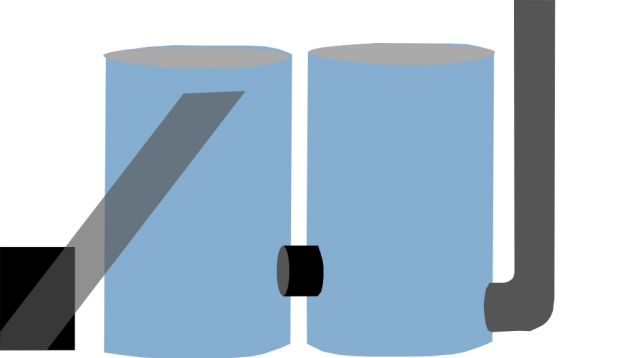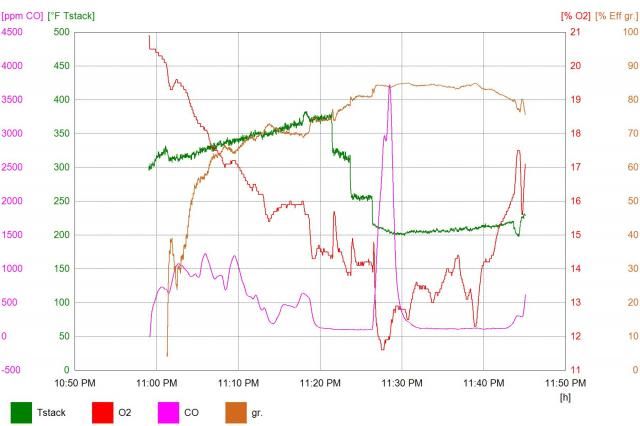Cramer
Junior Member
 
Posts: 129 
|
Post by Cramer on Jan 5, 2014 12:47:58 GMT -8
Your discovery Matt, thank you! I just hope the little test helps us along!
|
|
|
|
Post by kprata on Jan 20, 2014 16:07:59 GMT -8
I've been interested in building cook top height rockets for a while now, and recently had an accidental discovery that opened up some new options for me in this regard, using fairly standard known working rocket proportions, with a little twist. First, a little back story on how I discovered this. In the weeks running up to the Decathlon in DC last month, I was burning my Walker Stove daily. Sometimes inside, sometimes outside, to test various chimneys and the like. In the course of doing that, I was moving it around a bunch. Well, one night, after burning it outdoors that day, I moved it back indoors and lit it up to warm up the house. It was running just perfectly, and I went about my business. I came back into the room after a couple loads and as was my usual habit I pointed the IR gun at the surrounding combustibles to make sure I wasn't getting anything too hot, since I just kinda rigged up a place to burn the thing so I could test it. To my surprise, the ceiling, which usually was my foremost area of concern, was not hot at all. Weirder still, as I got near the stove, it was throwing a TON of heat off the front, which usually was the coolest part of the radiator. I pointed my IR gun at the top of the stove, and it was less than half of what I should have seen there. Pointed it at the front, and it was 900°f+! I pretty quickly figured out what happened, but what was surprising was that the stove was running so well. The riser had fallen over inside the radiator! And it still worked! I was excited, but it's taken me this long to get back into the swing of building test stoves and such and verify that this works. Well, it does, for sure. What this does is offer a whole slew of new options for shape/size/configuration of these stoves. By not having to set the first radiator on top of the core, you can save a bunch of height. In that way, it's a great solution for cook top height stoves. So far I've tested what I call the "broken riser," which replicates what happened inside my stove. I still make the core with the initial 12" high riser stub, then form an angled flange on top of that to mate the riser to. I tested one with about a 20° angle, and I've tested one that is almost horizontal. Both worked great, a little harder to start than normal, but once going they draw wonderfully. I haven't built the "angled riser" version, but I suspect it's even better. I'll try that next. Here's a couple quick drawings of the concept. In both cases I drew it as a double barrel bell system, but I think they would work with a variety of configurations. It doesn't seem to act any different than a regular J with a vertical riser. Broken Riser  Angled Riser  Hi Matt This looks very similar to the design of a "heat storage" stove. The AGA stove was designed in the UK in the late 19th / early 20th century. It seems to use bells, similar to another thread where Donkey mentioned he thought bells could be tuned for temperature. Here's a link showing a cut-away of the inside of an AGA -- www.chefcargo.com/aga_cooker.html |
|
|
|
Post by peterberg on Jan 26, 2014 1:25:41 GMT -8
About this broken and angled riser idea: I do suspect this will work as long as the end of the riser is sufficiently higher than the feed tube or combustion chamber. In my view, not the actual length of the riser does count here but the height difference instead. However, it could be helpful to direct the hottest gases to a direction one would prefer, the front of the stove for example. When all the above is true, the usable scope isn't that wide, not a cure for all diseases as it were.
Inevitably, there is some friction in the sloped part of the riser but that could be alleviated by the stack effect of the chimney. There could be a longer "stay" in the riser because of that friction as well, which is a plus for the Time aspect of the three T's.
Matt, I do hope you don't mind me criticizing your discovery.
|
|
|
|
Post by independentenergy on Jan 26, 2014 2:03:20 GMT -8
Hi
I did some testing without instrumentation because do not possess:
My broken riser (maybe wrong ..) and this:
batch box kitchen question
are not very experienced, but I noticed some things in my system Boken Riser.
The shorter the combustion chamber more smoke (seems obvious).
The heat riser seems to have the sole function of directing the heat but in my case it makes a lot more smoke and does not stop.
The draw is great with short combustion chamber.
I thought that having more friction inside the inclined riser, as Peter says, it would have been favorable to the "three T's" My flame but never reached that point.
As I mentioned I'm no expert and definitely do not allow myself to judge this work, it's what I've found in my system.
I hope you understand my bad English
|
|
|
|
Post by matthewwalker on Jan 27, 2014 9:32:59 GMT -8
Matt, I do hope you don't mind me criticizing your discovery. Not at all Peter, that's what we are here for. This is just a concept that may be a solution for some difficult configurations. I deconstructed my broken riser test stove before I had a chance to really run good tests on it, but I do have the one graph I posted for Pat of the stove. It's not really a fair test, but it did perform very similarly to my home system. Not quite as low on the CO, but averaged around 60ppm once it settled in and efficiency was actually higher than my home heater due to lower exhaust temps from wet cob. You can see me bringing the cob mass online via a bypass there where the temps work down through those plateaus. The chart is a mess, I was playing with bypasses, new layout ideas, and all sorts of stuff. But, you can see that it can indeed burn cleanly even with a broken riser. That's a new load of fuel at around 11:25, once the stove was warmed up. You can see it struggle with low O2 for a minute then settle in. This one has a 12" high vertical riser stub, then an almost 90°elbow, then 24" of riser laying almost horizontal. I would estimate height from floor of burn tunnel to riser exit to be around 20".  |
|
|
|
Post by ronyon on Sept 2, 2014 19:32:00 GMT -8
Any more discoveries in this vein?
|
|
|
|
Post by woodburner on Feb 8, 2015 15:47:49 GMT -8
This is an interesting observation Matt. I could have missed it in the posts, but my thoughts are that the angled or even horizontal "riser" is setting up a longer flame path by inducing a vortex. Makes it a bit more difficult to build a stove using minimum floor space perhaps. I was interested in the combustion figures, though, and it showed I had not looked in enough detail at Peter's previous figures. (Sorry Peter, oops ) I see you use an O2 measurement, have you tried using a CO2 display rather than the O2? The reason for asking is that I look after oil burners, and the most often used figures are Efficiency, CO2, CO, and ∆fT (ºC) . The efficiency is obviously calculated, the CO2 is either calculated, or a direct measurement depending on the instrument type, and the CO is a direct measurement from a sensor. We are usually looking for a CO2 figure of between 11% and 12%, this is the minimum amount of air mixed with the oil spray to narrowly avoid smoke, and corresponds to maximum efficiency. My apologies if you already know this, but never mind, there are others reading here that now know something new  It is interesting the stack temperature is so low, i presume that is from the stove output, and not just from the top of an exposed riser. Have you done any more development over the past year? |
|
|
|
Post by peterberg on Feb 9, 2015 2:03:21 GMT -8
In the case of the Testo 330, CO2 is calculated. When CO and/or O2 goes down, CO2 will rise. I'm looking at a spreadsheet now, when O2 is 10 % and CO 75 ppm the CO2 is 10.48%. At another point the values are 10%, 102 ppm, 10.48% respectively. And another 10%, 527 ppm, 10.48%. Hmmm... It looks like the CO is left out of the calculation and the O2 is the only factor.
And yes, the stack temp is taken from the stove's output. Apart from the Innovators Gathering in Missoula and a workshop in the Netherlands I only wrote about heaters rather than building those.
|
|
|
|
Post by woodburner on Feb 9, 2015 4:50:15 GMT -8
Thank you Peter. Even at 500ppm CO, the amount of unburnt carbon is very little, 0.05% if I'm not mistaken, so the effect on efficiency is very small. As the Testo uses an O2 sensor, the CO2 figure is just 20.9% - O2 and a small correction for intake temperature. More information here www.kane.co.uk/knowledge-centre/how-do-i-calculate-efficiency-on-wood-burning-appliances. I suspect you are aware of most of this. I have some insulated flue sections, and a 45º bend, so I must build one of these and see what happens. |
|